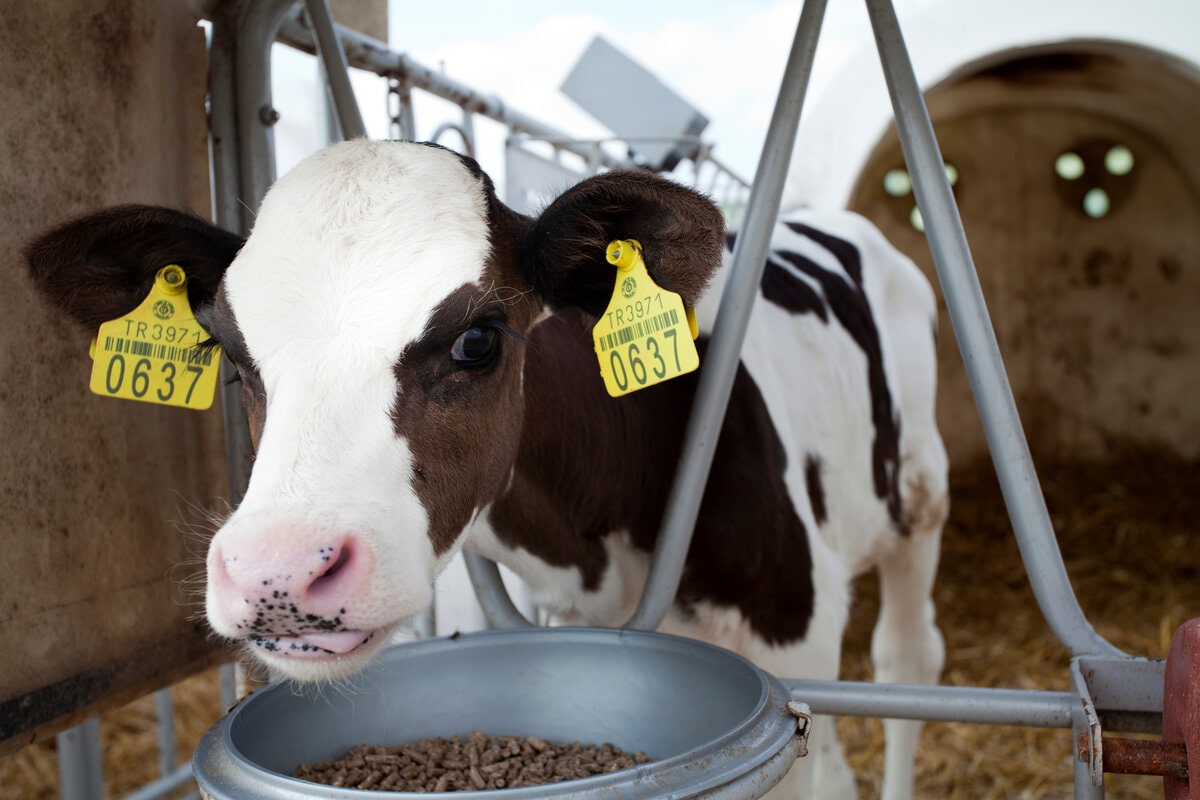The sooner your calves start feeding on a calf starter, the sooner they’ll be ready for weaning. However, calf starter feed should be introduced gradually to allow proper rumen development and prepare the calf for a complete transition to solid feedstuffs. Read on to learn valuable tips on transitioning and how to introduce the starter feed to calves to maximize their performance.
When To Start Feeding Calf Starter
You should provide a calf starter within three days after birth. Early intake of starter feed with water promotes rumen development. Don’t expect your calves to consume much of it initially, though.
In early life, you should focus on providing a good quality colostrum, a milk replacer, and water. But, they should be encouraged to eat small amounts of starter 1–3 days after birth. Delaying early starter intake will prolong rumen development and postpone the weaning age.
As your dairy calves grow, they’ll consume more starter feed. Starter intake is a critical weaning factor. Calves should be weaned once they consume about two pounds of starter per day for three consecutive days, which is usually between 5–7 weeks of age. If you don’t provide starter feed early on, you might delay the weaning process, and the calves may experience growth stalls and illnesses due to underdeveloped rumen.
Be sure to always monitor your calf starter inventory and keep fresh feed on hand. Calf starter should be stored in an area that is dry, clean, and covered to prevent any spoiling and wasted product. Keep track of your usage to make sure you keep the freshest possible feed available on your farm.
How To Get A Calf To Eat Starter Feed
Young calves can be picky eaters. But everyone loves fresh, tasty food — and calves are no exception. Here are a few ways to make the starter more appealing to your calves.
Keep the starter fresh.
Check the feed daily to ensure it’s clean and fresh. Discard any feed that is stale or wet. Even any feed that is over 24 hours old should also be discarded. The goal is to promote early starter intake, so only offer fresh starter to your calves.
A stale feed can appear good, to the human eye, for consumption, but calves are less likely to eat feed that is stale. Saliva can contaminate starter feed and promote spoilage, so it’s important to check the state of feed frequently during the first few weeks of life.
Be mindful of the starter amount.
Avoid giving calves too much starter at once to prevent spoiling and feed from losing its appeal. Calves like to lick the bottom of the feed bucket while eating, which is another reason to provide feed in small batches. It’s best to use shallow buckets as young calves may not be able to reach into a larger bucket. Big containers can put calves off and prevent them from seeing and smelling the dry feeds.
Offer plenty of water.
Water consumption and how it’s provided can make or break the starter intake. Provide lots of fresh water from day one. Free choice water available at all times increases starter intake and weight gain, while lack of it has a negative effect. But most importantly, water is critical for rumen development.
It’s best to provide water separately from the starter feed. If placed near one another, calves can spill the water into feed, causing it to spoil and mold. A divider between water and feed buckets can prevent contamination, but keeping the water away from the feed is ideal.
How Much Calf Starter Should I Feed
Calves should have access to about a handful of starter feed within the first three days of life. As they get older, they’ll eat far more. Here are some general guidelines on how much feed you should expect your calves to consume before they are ready to be weaned:
- First two weeks: Calves will only nibble on starter feed during early life. That’s okay. Gradually increase the feed availability from one handful to about 6-oz per day.
- Third week: You should see a noticeable interest in the starter feed. Calves should consume a little less than half of a pound of starter per day.
- Fourth week: The intake should double that of the previous week.
- Fifth and sixth weeks: The intake should grow significantly and reach the daily goal of about 2–2.5 pounds.
The actual starter consumption can vary depending on environmental conditions, season, health, breed, and starter mix. After your calves successfully consume about two pounds of feed per day for three days, they’ll be ready for weaning.
What Is The Best Calf Starter Feed?
Calf starter feed must be palatable and appealing to your calves, or they won’t consume it. It also needs to contain a high amount of crude protein, minerals, and vitamins for optimal health and weight gain.
Calves tend to consume more feed formulated with large particles in the mix than diets with fine particles, as noted by Pennsylvania State University. However, many other factors play a role in starter formulation, including storage, feed presentation, and calves’ eating habits.
Calf starters can vary in moisture, texture, nutritional content, smell, palatability, and cost. Every starter ingredient affects the whole mix, so producing the best starter for your calves requires attention to detail. Find a feed manufacturer ready to work directly with your nutritionist or consultant to craft a customized feed tailored to your calves’ unique nutritional needs.
Star Blends – Tailored Nutrition For Maximum Herd Performance
When it’s time to start your calves on starter feed, turn to Star Blends for help. Our experts are ready to create a custom feed that meets the nutrient requirements of cattle in all growth stages. Working alongside your nutritionist, we’ll consider all aspects of your calves’ lives, from environmental conditions to their unique health needs, to create the best calf starter feed for your goals. Contact us today to learn more.



